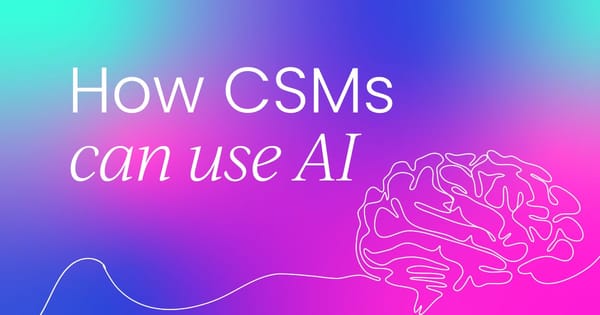“I know I should be using AI for my job, but I don’t really know where to start.”
This may be the most honest and relatable – and dare we say, unifying – reflection on the current state of AI in the workplace. With AI, you’ve got a whole lot of noise but not a lot of answers, which is a big thumbs-down in our book.
For Customer Success Managers, AI represents a massive shift in work priorities. It’s not about shiny tech or automating everything to oblivion, it’s about working smarter, making better decisions faster, and staying one step ahead of customer needs.
The best part? You don’t need to be an AI expert to start benefiting. From analyzing customer conversations to spotting churn risks, writing smarter emails, and prepping for high-stakes QBRs, AI is already baked into the tools many of us use every day.
In this guide, we break down 10 practical, real-world ways CSMs can use AI right now to deepen customer understanding, scale proactive support, boost productivity, and level up their strategic value.
Keep reading to find out what modern CS looks like.
1. Extracting actionable insights from customer interactions
The days of fumbling around in the dark are over. AI tools can analyze thousands of conversations (calls, chats, emails, support tickets) in real time.
You only have to wind the clocks back a few years to appreciate just how revolutionary this is.
Tools with built-in AI don’t just log activity – they interpret intent, track themes, highlight churn signals, and identify new opportunities across your entire customer base.
From summarizing feedback across Slack or Teams messages, interviews, and surveys to detecting recurring complaints or knowledge gaps, AI helps CSMs go from guesswork to precision.
Want to know what’s frustrating your enterprise clients during onboarding? Or what themes are tied to churn in mid-market accounts? Ask, and AI delivers contextual answers fast.
Support tickets, NPS responses, and sales calls now become a goldmine of insight, not a graveyard of missed signals.
2. Monitoring product usage and telling data-driven stories
Just launched a new feature? Rolled out a bug fix? You hope things are going well… but a hope and a prayer is not a strategy.
AI gives CSMs a live dashboard of how customers are interacting with the product, warts and all. What does it analyze? We’re talking: usage patterns, session data, and support conversations – the lot. AI tools can surface early signals like adoption drop-offs, error spikes, or sudden workflow shifts.
And when it comes time to report, AI does the heavy lifting. Need a root cause analysis? A business case for more headcount? A trend report for leadership? AI helps quantify impact and propose next steps – no data analyst required.
Less spreadsheet wrangling. More storytelling with data.

3. Driving intelligent, personalized engagement
CSMs have historically been stuck in the purgatory of time-triggered playbooks: day 30, send "this" email; day 60, send "that" follow-up. AI changes that.
Now, your outreach can be based on what’s actually happening – in-product behavior, sentiment shifts, or success milestone completion. AI-generated emails sound like you – but with superpowers, referencing recent usage trends, company news, or progress milestones.
It can also segment customers dynamically and predict behaviors like expansion readiness or churn risk. Smart nudges trigger alerts when usage drops or a power user vanishes, so you follow up before the fire starts.
And honestly? Customers do notice the difference. Relevance is the winner here, folks.
4. Smarter onboarding for customers and CSMs
No two customers are the same.
A Head of Ops in fintech will need a totally different onboarding path than a Product Manager in healthcare… so why would you onboard them in the same way?
AI lets you tailor customer onboarding content based on role, industry, goals, or even learning style. It can generate interactive tutorials, walkthroughs, and support documentation dynamically.
The same goes for new hires.
Instead of firing over spreadsheets and outdated docs, you can hand them AI-generated summaries of each account: product usage, decision-maker intel, support history, and more.
And if there's been a big gap between CSM hires, you know how challenging it can be to get new team members up to speed on everything that's changed.
5. Automating operational and communication workflows
CSMs juggle a lot. But do they really need to manually log every call, draft every summary, or build every renewal template? (The answer’s no if you were wondering.)
AI handles recurring tasks like follow-ups, CRM updates, calendar scheduling, and even QBR prep. It’s like having a virtual assistant that works 24/7 and never asks for coffee.
Tools like Fathom, Otter.ai, and Zoom's AI Companion summarize meetings, extract action items, and suggest follow-ups. You still bring the human insight; AI just accelerates your ability to communicate it.
6. Becoming a knowledge hub with instant retrieval
Digging through Confluence pages, Slack threads, or old onboarding docs is a serious productivity killer.
Internal AI assistants like Atlassian’s Ask AI or Guru’s AI Search make finding institutional knowledge fast and painless. Ask a question in plain language: "What’s our SLA on implementation delays?", and get a clear, contextual answer instantly.
At the same time, as AI tools become more common, CSMs need to explain them clearly to both technical and non-technical stakeholders. Being able to demystify how AI models work, or why a chatbot behaves a certain way? Now that’s real influence.
You don’t have to become an engineer, but you do need to be a translator.

7. Proactive customer health management and risk mitigation
AI’s risk radar is always on.
It picks up subtle cues – declining usage, negative sentiment, unresolved tickets, and ghosting execs – and connects the dots before the situation escalates. It flags risks early and can even suggest mitigation tactics.
Need to brainstorm a renewal-saving action plan? Tools like ChatGPT or Notion AI can draft one based on similar past cases. Instead of panicking at QBR time, you’re ahead of the curve.
8. Scaling strategic reporting and decision-making
AI helps turn raw data into strategic insights. Whether it's visualizing trends across accounts or generating leadership-ready reports, you no longer need to rely on a data team to get answers.
From forecasting risk and expansion to drafting business cases or justifying program changes, AI lets CSMs tell compelling stories backed by evidence. It doesn’t just crunch numbers, it elevates them.
9. Elevating your role and technical fluency with AI
AI isn’t replacing CSMs, it’s upgrading them. The best CSMs of tomorrow will be those who can harness AI tools to work smarter, not harder.
Knowing how to use AI effectively is fast becoming a core competency, not a nice-to-have. Whether it’s analyzing customer data or streamlining operations, AI fluency will set you apart. It’s all about staying relevant and sharp.
10. Turning feedback into high-impact internal advocacy
CSMs are the voice of the customer – you don’t need us to tell you that! But that voice is staggeringly more powerful when amplified by AI.
Modern tools surface actionable insights from conversation data and user behavior, making it easier to funnel specific, quantifiable feedback to product, sales, and engineering.
The best way to approach this is to re-align your mentality to “38% of enterprise users struggle with our mobile login flow,” rather than, “I guess some folks are complaining?”
AI turns anecdotal feedback into evidence-backed advocacy. And that kind of clarity gets results.
Important considerations for Customer Success Managers using AI
Trust but verify
Always evaluate AI-generated output for accuracy, tone, and alignment with your communication goals. Critical thinking remains essential.
Maintain a personal touch
Even with automation, ensure your communications reflect a human voice. Customers can tell when responses are overly generic or robotic.
Data security and privacy
Protect customer data by ensuring AI tools follow strict data governance policies. Avoid using sensitive data in tools that train public models and prioritize solutions with strong privacy guarantees.
Strategic adoption
Start by applying AI to high-impact, low-resistance areas to achieve early wins and build momentum for broader adoption across the team.

How to implement AI in CS workflows the right way
You might think that implementing AI in customer success workflows starts with technology, but you'd be wrong. It starts with tasks.
Christine Lawther, Director of Customer Success at Sprout Social, shared a practical strategy that helped her team go from 0 to 80 instances of AI adoption.
Her method?
Start small, stay specific, and prioritize usability
The first step is to zoom in on one specific CS role – say, a Customer Success Manager – and list out their core responsibilities. These might include sending proactive outreach, drafting QBR presentations, or identifying churn risks.
Once the tasks are clear, the next move is to listen.
Listen for the pain points
What Christine did was gather pain points from her team, such as the time spent pulling data or the struggle to get up to speed with new accounts. Mapping those frustrations back to core tasks helps pinpoint where AI can have the biggest day-to-day impact.
Then comes diligence mapping – a unique tactic in AI strategy.
Partner up with your tech counterpart
This means partnering with a technically fluent colleague (like a business systems lead) who knows your company’s AI capabilities inside out. Together, you align business value with technical feasibility.
Prioritize for quick wins, not perfect impact
Critically, Christine Lawther recommends prioritizing tasks where AI is most likely to be adopted, not necessarily where it’ll drive the biggest impact. Early wins, like using NotebookLM to summarize customer intel or Gemini to draft value-based emails, build momentum. Over time, these micro successes stack up.
Finally, change management has to run in parallel.
Don’t skip the change management
Christine used techniques like the "Rule of Seven" to regularly expose her team to AI in meetings, 1:1s, and safe practice sessions. By reinforcing intent – helping the team work smarter, not harder – she created buy-in across the board.
With the right mix of task-level focus, cross-functional collaboration, and consistent support, integrating AI into CS workflows can be more than a tech upgrade – it can be a true team transformation.



 Follow us on LinkedIn
Follow us on LinkedIn





